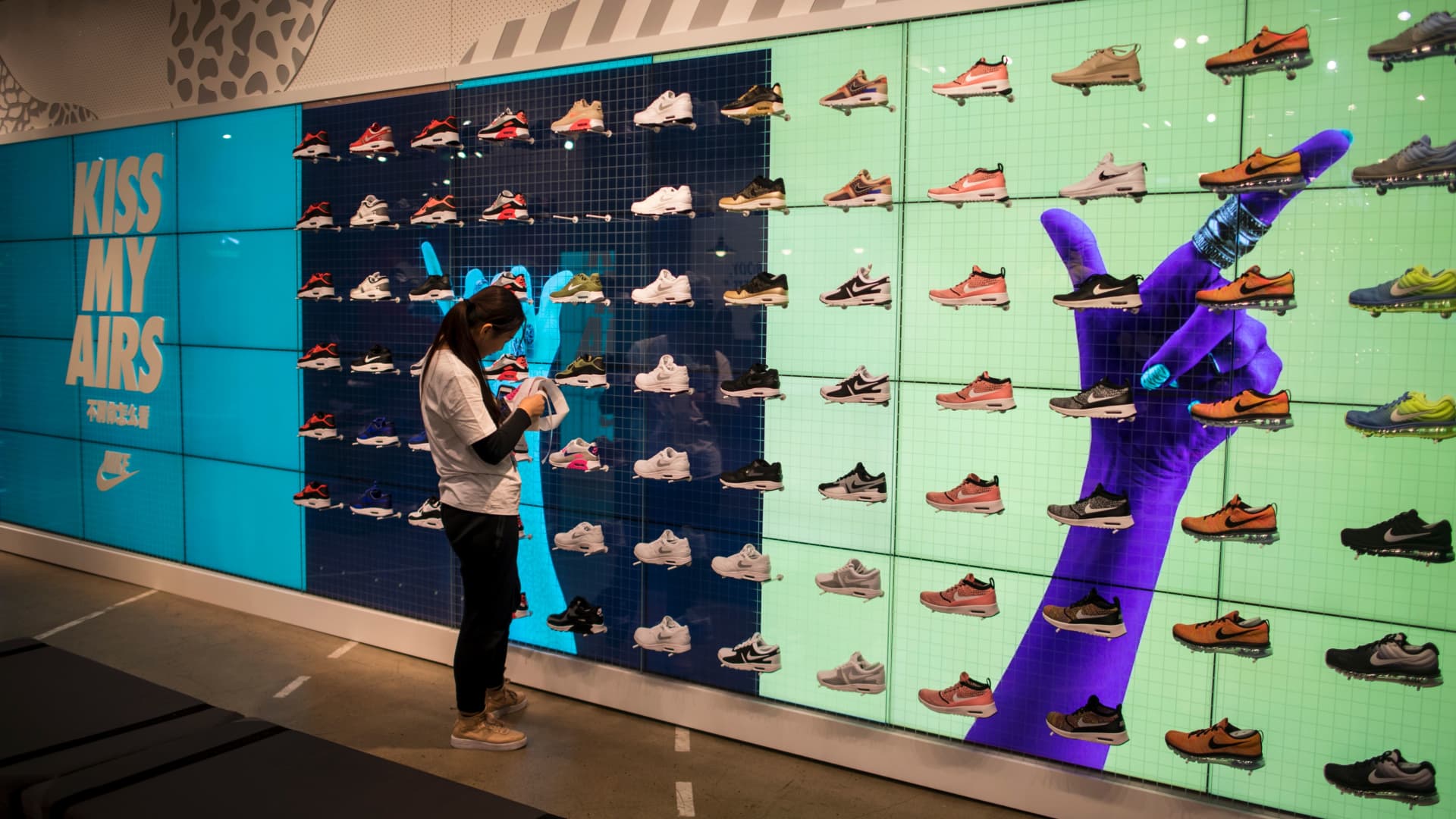The state of women's sports: Top executives weigh in on parity, media share and NIL regulations
Women's sports reached an inflection point in 2023, propelled by major new broadcast deals, once-in-a-lifetime players and record-breaking audiences.

Guard Caitlin Clark #22 of the Iowa Hawkeyes listens as the crowd cheers after breaking the NCAA women's all-time scoring record during the game against the Michigan Wolverines at Carver-Hawkeye Arena on February 15, 2024 in Iowa City, Iowa.
Matthew Holst | Getty Images
Women's sports reached an inflection point in 2023, propelled by major new broadcast deals, once-in-a-lifetime players and record-breaking audiences that dramatically changed the sports landscape.
From Caitlin Clark fever in Iowa to a packed house of 92,000 fans for women's volleyball in Nebraska, women's sports have never been more at the forefront.
And it's not slowing down.
Revenue generated by women's elite sports could surpass $1 billion this year, a 300% increase from 2021, according to estimates from Deloitte.
Bigger media deals and more commercial sponsors are driving record valuations for women's sports, with several teams' values expected to exceed $100 million in 2024, according to Deloitte.
Last year saw record media deals for women's sports as the NCAA and NWSL both inked groundbreaking agreements. And investors from private equity to celebrities are lining up to get in the game.
Yet, there's still a lot of work to be done, specifically, in the areas of equal pay, prime-time access and even the need for more historical data.
CNBC surveyed some of the most high-powered women executives in sports, ranging from league commissioners to team owners and CEOs, to hear their thoughts on the state of women in sports. Some of their answers have been edited for style, clarity and length.
What do you see as the primary obstacle hindering the growth of women's sports?
Renie Anderson, executive vice president and chief revenue officer for the NFL: The obstacle, or really the opportunity, for today is to continue to amplify the spectacular athleticism of these women. Rather than be shocked and surprised that women are spectacular at sport, we need to do a better job of weaving in the message of greatness when highlighting the greatness in men's sports. It's there. It just doesn't get the attention it deserves.
Jessica Berman, National Women's Soccer League Commissioner
Jesse Grant | CNBC
Jessica Berman, commissioner of the National Women's Soccer League: Because the world has woken up to women's sports, the expectations on how fast this can grow, from all stakeholders, is really challenging. We're 100 years behind men's sports, and so it's not to say that we should move slowly. It is to say that it is challenging to sort of build the plane as quickly as so many stakeholders expect it to be built — and to do it in a way that's sustainable and commercially viable.
WNBA Commissioner Cathy Engelbert speaks to the media to award Breanna Stewart #30 of the New York Liberty with the 2023 Kia WNBA Most Valuable Player Award before the game against the Connecticut Sun during round two game two of the 2023 WNBA playoffs on September 26, 2023 in Brooklyn, New York.
David Dow | Getty Images
Cathy Engelbert, commissioner of the Women's National Basketball Association: One of the obstacles is the undervaluation of our assets. Whether it's a patch on the uniform or an ad buy on a broadcast, we need to change the model. It's based on decades-old spreadsheet models that are tailored to men's sports and in those models, a lot of things that companies are now supporting in women's sports aren't being accounted for like their diversity, their community, the fact that they are not the "one and done" type.
Jessica Gelman speaks during the 15th Annual Sports Business Journal Awards ceremony at New York Marriott Marquis Hotel on May 18, 2022 in New York City.
John Lamparski | Getty Images
Jessica Gelman, KAGR CEO and founder of the MIT Sloan Sports Analytics Conference: A major obstacle has been available data on performance which supports and enhances storytelling. These stories create interest and drive (i.e. see Caitlin Clark's NCAA scoring record quest). This past year the MIT Sloan Sports Analytics Conference donated to Sports-Reference to support the addition of college women's data back to 1987.
Jayna Hefford, senior vice president of operations for the Professional Women's Hockey League: Women's sports still struggle to secure prime broadcast windows, consistent airtime and traditional media coverage. Furthermore, the scarcity of traditional media coverage has historically forced women's teams and leagues, as well as women-owned media companies, to take the lead in promoting their own narratives. This limited visibility has made it challenging to attract brand support, even though research indicates that companies investing in women's sports see lucrative returns.
Haley Rosen, Just Women's Sports
Source: Just Women's Sports
Haley Rosen, CEO and founder of Just Women's Sports: One of the biggest obstacles hindering the progress of women's sports today is relying on the legacy platforms. Legacy platforms aren't set up to support women's sports and build on the momentum. Yes, they'll air the games. But there's only so much time in the day for the shoulder programming and coverage needed to amplify the women's leagues, and legacy platforms are always going to prioritize men's sports. Viewership numbers are rising, but the relative percentage of women's sports coverage on legacy platforms hasn't changed.
Mollie Marcoux Samaan, LPGA Commissioner, speaks during the State of the Association press conference during the first round of the CME Group Tour Championship at Tiburon Golf Club on November 16, 2023 in Naples, Florida.
Michael Reaves | Getty Images
Mollie Marcoux Samaan, commissioner of the Ladies Professional Golf Association: Women's sports today face two primary obstacles: investment and exposure. At the LPGA we've made some great strides. Our total revenue has gone up 65% in the last four years, and total purses — the prize funds players' play for each week — has grown 70% since 2021. That's because of investment, because of partnerships, because of corporate decision makers seeing not only the significant commercial value of the LPGA but also the opportunity to have a positive impact on the world.
How can women's sports leverage milestone events like those seen in 2023 to further expand reach?
NEW YORK, NY - AUGUST 22: USTA President Katrina Adams speaks during the Louis Armstrong Stadium Dedication Ceremony at USTA Billie Jean King National Tennis Center on August 22, 2018 in New York City. (Photo by Steven Ryan/Getty Images)
Steven Ryan | Getty Images Sport | Getty Images
Katrina Adams, former pro tennis player and ex-CEO of the United States Tennis Association: I think what the Women's Tennis Association has done for many years, is shown other professional sports what can be achieved if they use your voice and their talent, that they can survive. When you look at the players of today — you know, we talk about the [Caitlin Clark types] and Sabrina Ionescu and Coco Gauff, who was the highest paid athlete last year — there's so many opportunities for these young women to use their platform to really speak up and speak out on what it means to be on a level playing field week in and week out.
Berman: I think we have to go from these being moments to being part of a movement, so that we get out of the default of having these reference points be episodic, or transactional or in isolation, so that it can translate to more sustainable growth and investment. I think the more we can demonstrate and talk about some of those consistent data points that show that the business is actually being built in a more consistent way, the easier it'll be to debunk the narrative that these are one-off success stories.
Pamela Duckworth
Source: FuboTV
Pamela Duckworth, head of Fubo Studios at FuboTV: Female athletes are multifaceted — they are also mothers, businesswomen, philanthropists, media moguls and more. We can use the momentum from attention-grabbing sports moments to bring athletes' stories to the forefront and connect with broader audiences that way.
Engelbert: Sports is about marketing, marketing, marketing. If you look back at the history of the NBA that put the league on the map and the multibillion-dollar deals, it was a rivalry coming out of college, Magic Johnson and Larry Bird. Then it was a marketing genius with Michael Jordan and Nike. But you need capital to market and advertise. I think the marketing strategy we put in place now that we have this capital is to build household names, create rivalries, and promote games or events of consequence.
Fanduel CEO Amy Howe attends The Future of Everything presented by the Wall Street Journal at Spring Studios on May 18, 2022 in New York City.
Steven Ferdman | Getty Images
Amy Howe, FanDuel CEO: Women's sports need to continue to position their star athletes (i.e. Ionescu, A'ja Wilson and Breanna Stewart of WNBA) in the mainstream at parity with their male counterparts – the 3-point competition was a perfect example. Not surprisingly, all of this investment and support is fueling greater performance from female athletes which is driving added success in places like FanDuel's business, where we saw a 270% increase in bet counts on women's sports and 101% increase in handle, or amount wagered. It's a real flywheel effect.
Rosen: There are tens of millions of sports fans out there waiting to be onboarded into this space. We have to make it easy and fun for them to be a women's sports fan and not just rely on the stand-alone moments. That means meeting them every day on their feeds, creating content that engages them and keeps them continually connected to this space.
Kelly Laferriere, chief business officer, A-Rod Corp.:
The investment community and media companies are taking notice. They recognize the strategic value. Distributing women's sports content across multiple media platforms to reach the widest possible audience will drive new revenue and keep women's sports part of mainstream conversations. The Paris Olympics in July also creates an opportunity for female athletes to shine on the world stage.
How do name, image and likeness regulations factor into the growth of women's sports?
Adams: I think it's an opportunity for our women to finally be recognized and actually make a living. The men, they've had this opportunity for years, for decades, "under the table," if you will, now the women are able to do it legally with the NIL. For them to make a little money and really grow the sport in their communities, in their cities in their college towns, etc. I think it's great. They're learning how to become entrepreneurs at a younger age, and they're doing extremely well.
A portrait of Renie Anderson NFL SVP, Chief Revenue Officer.
Source: NFL
Anderson: I think NIL helps likely a small few through their social media. I'm not sure outside of a handful of amazing athletes/influencers it's going to be spread out throughout college sports for women, like it is for football for men. But I guess we wait and see. I don't think it hurts, but for those few women that do benefit, it's an opportunity for them to lift up other women.
Duckworth: NIL opens doors for female athletes to build their own brands in ways that weren't possible before. Why shouldn't a female athlete make money the same way her male counterpart can? Money equals independence in my book. Kudos to major sports stars like Angel Reese or Caitlin Clark on showing young women just what can be built.
Billie Jean King and Jayna Hefford walk to centre ice for the ceremonial puck drop before Toronto plays New York in their PWHL hockey game at the Mattamy Athletic Centre on January 1, 2024 in Toronto, Ontario, Canada.
Mark Blinch | Getty Images
Hefford: The positive impact of NIL on women's college athletics has reverberated throughout women's sports, creating a scenario where all boats rise. As more female athletes become household names, the investment in women's sports is likely to increase, encouraging more young girls to start — or continue participating in — sports.
Rosen: On paper, it's great and we should celebrate anything that helps women athletes grow their brand and monetize their talents. There are obviously still some details that need to be ironed out, especially when it comes to team dynamics and the potential for NIL deals to force players into taking the short-term profit at the cost of their long-term development.

 UsenB
UsenB 



























.jpg&h=630&w=1200&q=100&v=154b70b92d&c=1)



